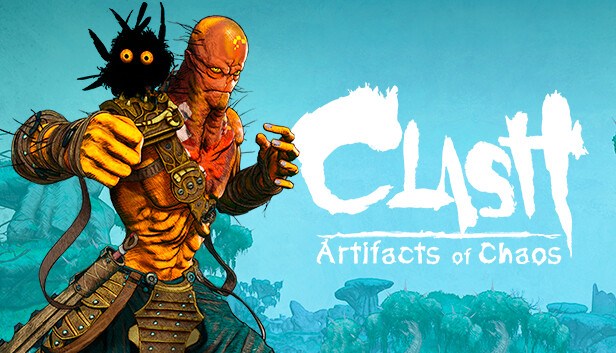For this review, we shall look at Clash: Artifacts of Chaos using the Steam version developed by ACE Team and published by Nacon. Known for other souls like SteelRising. Initial impressions of this game are of popping colours that look like they’re straight out of a comic book similar to Borderlands, and I adore how they’ve made it appear so appealing and a piece of art, though you can turn off the stylised comic book lines if you would rather.
This doesn’t look like the main character

You are abruptly thrust into the world without grasping what is happening. Who am I pretending to be? What exactly am I? All we know is that we are a thing known as Pseudo.
We start in the night-time as what was initially thought to be a skeleton being or a husk, but it turns out you are made of wood. Playing through the tutorial, you find a body on the floor. This is where you become your daytime flesh being, which certainly isn’t the best thing to be looking at.
The reasons for these two modes are that during the day, the colours are more vibrant and colourful; you can use the shops and challenge people to a game of dice before the battle (more on that later). In contrast, during the night, you have no access to upgrading yourself or using the shops, and the enemies you fight are direct battles regardless of whether they are formidable enemies or general ones.
You can also traverse through different areas of the map by going through thorny bushes; sometimes, you will find an enemy which, once defeated, removes the brush, allowing your daytime form to come through.
Instead of choosing weapons in this game (though they exist), you are more based on the fighting stances. You can choose between three at the start of the game; nevertheless, you can unlock different ones as you progress, provided you win specific battles found at totem poles.
Clash of intelligence

Our story starts when we come across a battle between an elderly man and a bandit using the dice game and artefact mechanics; this can only be used with enemies that can talk. Unfortunately, this battle ends in the death of the elderly man, and from here, we take a little side character known as “boy”. He isn’t helpful, just simply along for the ride, similar to Daxter of the first Jak and Daxter game or Clank of Ratchet and Clank. However, should we see a second game, this character may prove to be more useful in future iterations. So our little side character rests on our shoulders unless we are fighting. He is the key of power in this game, sadly considering himself a curse able to heal but also damage. We are to protect him from our main overbearing antagonist “Gemini” who wants “The Boy” to help heal her other heads and secure how power; there is also talk of someone called “The Director”, who could also be Gemini, but we are not too sure yet.
With the battle of dice, we choose an artefact that will apply a bonus or a penalty if we win the dice game (for example, the opponent suffers a wasp attack, or you will have the opportunity to summon a past enemy) we launch dice on the table. We modify them with the objects in our belt, for example, to reduce dice numbers or protect our dice. You can find new artefacts along the way. You do not have to use the dice method; if you just want to rush into battle, you can.
The fighting is taken mainly by different fighting stances and the need to dodge; you can find and purchase weapons to boost your attack, but you will primarily be fighting with your fists. So knowing when to dodge and when to parry is vital. Though dodging didn’t always feel like it would work as it should, dodging backwards gives a wide birth, but dodging to the side is more of a light move and doesn’t allow you to avoid damage. Also, when playing on a mouse and keyboard, the camera angles can become confused quickly, and you can end up missing even if you had locked on (the lock-on mechanic was not told and was only discovered from looking at the controls). Thus it became apparent that playing via a controller was the way to go for this game.
From here, we have our RPG elements of making different potions and levelling up our character, but these do little you harvest other materials for your potions and then mix them. Instead, it creates a potion but doesn’t tell you what it will do until you drink it. When levelling up your character, this is done through XP and gaining points, but it can also be done through collecting little dolls. Nevertheless, the increase is so minimal that you can’t tell if your character is more robust.
Lost in the Clash

I’m not sure how much I can complain about the lack of a compass or mini-map because it reflects the creative team’s strong artistic desire, which presupposes a semi-open environment in a labyrinth. But, as swiftly as one may travel, the sense of being lost and passing over the same place ten times without knowing if something had been missed or not can be uncomfortable.
The maps can be vast, some with no or very few enemies at all and your main goal are simple to search for things other than the guidance of what you could climb, and when you needed to be in night mode, you were left to your own devices and would revisit the same place many times. Sometimes defeating a boss and not knowing where to go next at all. It made it seem like the story had branching paths, and it would become worrisome that you might miss out on story elements by going the wrong way, but you wouldn’t as you’d be forced to circle back, which could be a problem if you had taken a path and fought a lot of enemies for no real reason. Patience is key when playing this game, or you’ll get frustrated quickly.
Music, Graphics and Overall

Clash of Chaos Artifacts is an average level of the difficulty-action game. The battle system is fast-paced, but the exploring part of the game is tedious. Nevertheless, it looks fantastic, with wonderfully interesting-looking characters.
However, the game’s structure and lack of advice leave a bitter taste of frustration. You will play it through quickly to uncover the confusing story and landscapes. Or you will need to take a break because it’s too repetitious. The music can be hit or miss. It’s engaging, dark or fun. Occasionally, you’ll wander through empty space. Then, suddenly, an epic soundtrack will play for no reason, confusing the player into thinking something special is about to happen, but then it doesn’t.
Overall the game is worth a play if you can handle the lack of mission guidance.
Platforms: PlayStation 5, PlayStation 4, Xbox One, Microsoft Windows, Xbox Series X and Series S
Enjoy the review? want to read more of our reviews? then click right here to be whisked away to the realm of our opinions.








You must be logged in to post a comment.